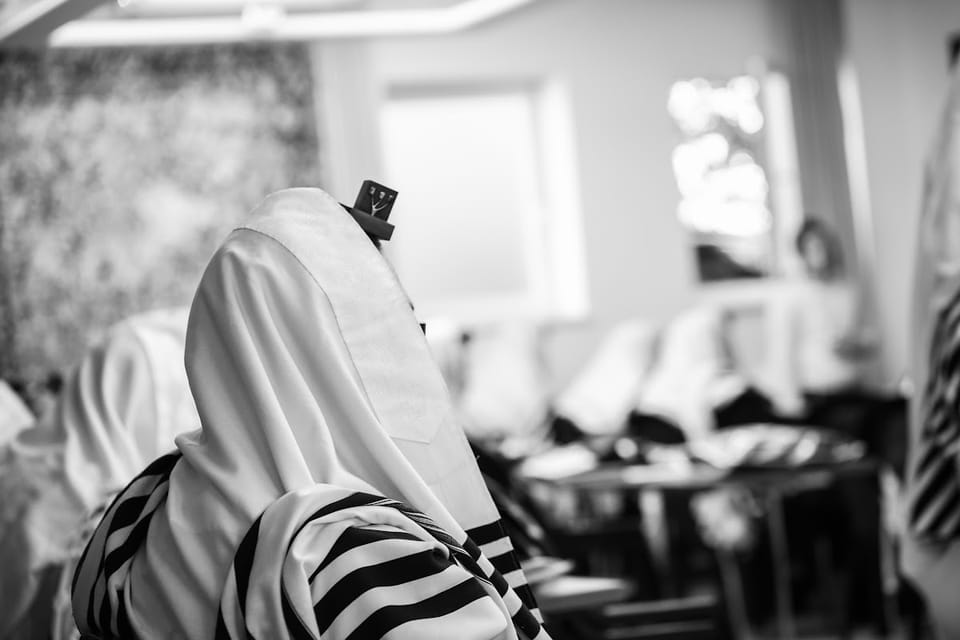Why Do Charedim Cover Their Heads with a Tallis When Davening?

To the outside observer, a man wrapped in a tallis over his head might appear concealed or distant. But to the Yerei Shamayim, it is just the opposite: it is the deepest closeness to Hashem, the most dignified submission, and a powerful halachic and spiritual act. Charedim cover their heads with their tallis during tefillah not out of habit or symbolism alone—but out of halacha, kavod, and a profound awareness of Whom they are standing before.
Let’s explore the layers behind this practice, from Shulchan Aruch to the Zohar HaKadosh.
1. It’s a Halachic Obligation—Not Just Custom
The Shulchan Aruch writes clearly:
"יש להתעטף בטלית ולהקיף בו כל גופו, ויניחו על ראשו עד שמכסה פניו..." “One should wrap himself in a tallis, surrounding his whole body, and place it over his head until it covers his face…” — Orach Chaim 8:2
The Mishnah Berurah explains:
"זהו עיקר עטיפה... ויראה כעבד העומד לפני רבו ביראה." “This is the primary way to wear a tallis… he should appear like a servant standing before his master with awe.” — Mishnah Berurah 8:4
Covering the head is not an embellishment—it is the essential fulfillment of “atah or kasifin” (wrapping), done to approach Hashem with fear and dignity.
2. It Symbolizes Yirah and Anavah – Awe and Humility
Standing before the Ribono Shel Olam requires a state of trembling respect. Covering one’s head entirely during Shemoneh Esrei is a tangible act of humility—like a servant afraid to look up at his master.
Rav Shlomo Zalman Auerbach zt”l once said:
“When I pull the tallis over my head, I am leaving the world behind and entering a private chamber with Hashem.”
Just as Moshe Rabbeinu hid his face at the burning bush:
"ויסתר משה פניו כי ירא מהביט אל האלקים" “And Moshe hid his face, for he was afraid to gaze upon Elokim.” — Shemos 3:6
So too, we hide our faces—not out of fear of distance, but out of awe at closeness.
3. It Brings Concentration (Kavanah)
Chazal emphasize the importance of removing distractions during tefillah:
"אל תתפלל אלא בבית כנסת... במקום קבוע... במקום שאין שם דברים המפסיקים." “One should only pray in a shul… in a fixed place… in a location without distractions.” — Berachos 6b
The tallis over the head helps a Yid block out the world and focus deeply on his tefillah.
Rav Chaim Kanievsky zt”l would often daven with his head completely covered, even when no one was watching—because he was talking to HaMelech.
4. The Zohar: It Brings Kedusha and Elevation
The Zohar HaKadosh teaches that the tallis brings ruach elyonah—a holy spirit of elevation:
"מי שמתעטף כראוי בטלית זוכה להשראת רוח קדושה מלמעלה." “One who wraps himself properly in the tallis merits the resting of a holy spirit from Above.” — Zohar, Parshas Shelach 161a
It becomes a holy cloak, drawing spiritual light and separating the davener from impurity.
According to Kabbalah, the tallis encloses the person in a cloud of kedusha, similar to the Ananei HaKavod in the Midbar.
5. Only Married Men Cover Their Heads—Why?
In most Ashkenazi Charedi communities, unmarried men do not yet cover their heads with the tallis, and only begin doing so after marriage. The reasons include:
- Minhag Yisrael: This is a longstanding custom with deep roots (see Magen Avraham, O.C. 8:3).
- Symbol of Responsibility: Marriage marks a man’s entry into full communal obligations.
Dignity in Tefillah: The tallis becomes a sign not just of yiras Shamayim but also of maturity and full engagement in avodas Hashem.
However, in many Sefardi and Chassidic communities, even unmarried men cover their heads with a tallis.
6. The Tallis is a Visual Protest Against Superficiality
In a world that increasingly celebrates externalities, selfies, and self-promotion, a Jew pulling a tallis over his head says: “I’m not here to perform. I’m here to submit.”
As Rav Aharon Leib Shteinman zt”l put it:
“When the tallis covers the head, it reveals what’s inside the heart.”
Conclusion: A Canopy of Kedusha
The tallis over the head is not just fabric. It is armor, a sanctuary, a bridal canopy, and a surrender flag—all at once.
The Charedi Jew wraps himself fully, hides from the world, and pours out his soul.
Not for display. Not for culture. But because when you meet the King of Kings… you cover yourself in trembling, and let your tefillah rise.
Sources
- Shulchan Aruch, Orach Chaim 8:2
- Mishnah Berurah 8:4
- Berachos 6b
- Shemos 3:6
- Zohar, Parshas Shelach 161a
- Magen Avraham, O.C. 8:3
- Heard in the name of Rav Shlomo Zalman Auerbach zt”l and Rav Aharon Leib Shteinman zt”l
